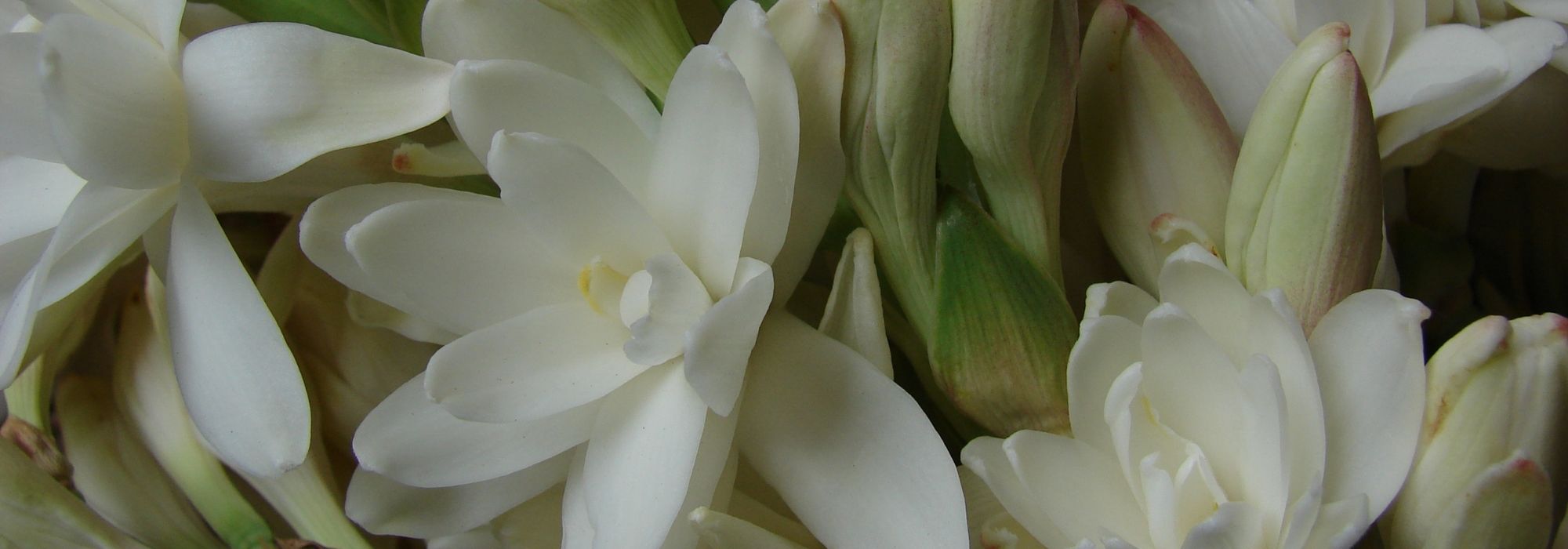
Tuberoses: planting, cultivation and care
Contents
Tuberoses in a nutshell
- Tuberoses or polianthes are rhizomatous plants with flowers in spikes.
- They fascinate with their entrancing scent, one of the most intense in the vegetable kingdom.
- Their flowers are semi-double or double, star-shaped, most often white but also yellow, purple or pink.
- They are tender and frost-sensitive plants; plant them in full sun in warm soil.
- Tuberoses are particularly well suited to growing in pots.
A word from our expert
Tuberoses are rhizomatous plants, introduced from South America by explorers, and for several centuries have charmed us with their fragrance. In summer they proudly bear a flower spike that can reach one metre in height. Organised in spikes, the small star-shaped flowers are most often white, but also pink, yellow or mauve. They can be semi-double or double and emit a delightful fragrance, even stronger in the evening.
Native to sandy regions of Mexico, Tuberoses prefer sunny, wind‑sheltered exposures, warm, rich, moist, well‑drained soils. Plant them in spring once frosts are no longer a risk.
In Mediterranean regions, Tuberoses do well in the ground. Elsewhere, favour planting them in pots and place them on your path to make the most of their fragrance.
Description and botany
Botanical data
- Latin name Agave polianthes
- Family Agavaceae
- Common name Tuberose
- Flowering from July to October
- Height between 80 and 120 cm
- Sun exposure sunny
- Soil type rich, fresh and well-drained
- Hardiness Low
It is commonly thought that tuberoses belong to genus Polianthes but following a recent revision that genus no longer exists and has been included in genus Agave. Formerly Polianthes tuberosa, tuberoses are now known as Agave polianthes (from Greek poli = grey-white and anthos = flowers). This large genus contains 268 species in the latest nomenclature, many known as Agave, native to Central America and northern South America. Agave polianthes is endemic to Mexico, particularly the Mexico region. The subtropical climate of this area dictates tuberose cultivation requirements: dry, frost-free winters, hot rainy summers and soils rich in organic matter.
Today tuberoses are becoming rare in their natural habitat but are widely cultivated worldwide for the perfume industry. Introduced to Europe in the 17th century, they quickly won favour for their sweet, spicy and heady scent. Louis XIV is said to have had 10,000 bulbs planted at Versailles.
After being one of Grasse’s specialities, tuberoses are now mainly grown in India, where they find the warmth they need. Tuberoses are sometimes called Indian hyacinth.
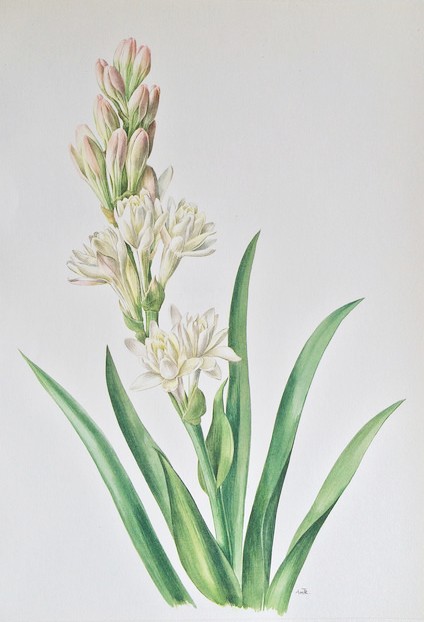
Agave polianthes – botanical illustration
Tuberoses are perennial, rootstock-bearing and semelparous: they flower only once before dying. No need to worry though — each rootstock produces two to three daughter rootstocks that will take over and flower after one or two years.
A basal rosette of leaves forms at the plant base. This deciduous foliage consists of long, lanceolate, ribbon-like leaves which can exceed 50 centimetres.
Above this foliage rises a long flowering stem that can reach one metre in height. The flowers form a pretty spike 15 to 40 cm long, more compact in newer cultivars, bearing around ten flowers on ‘La Perle’, and up to 40 on more recent selections. Star-shaped and with a waxy appearance, the flowers open progressively from base of spike to its tip. Wild species are single with six petals but most garden tuberoses are semi-double (with two or three ranks of petals) or even double.
The most common cultivar, La Perle, is white with pink flower buds, but botanical species display a great diversity of colour: white, purple, pink, yellow, orange… Interspecific hybrids have been produced by crossing Agave howardii (syn. P. howardii) with La Perle. These descendants have inherited the rich colours of the botanical species: violet for ‘Sensation’, pink for ‘Pink Sapphire’, yellow-green for ‘Super Gold’ or clear yellow for ‘Yellow Baby’, … More than 50 new cultivars have been developed.
One of the most striking characteristics of tuberoses is their scent. Intense, heady, sweet and spicy, it is arguably one of the most powerful scents in plant kingdom. Widely used in perfumery, it is reminiscent of other white flowers, but more voluptuous, such as vanilla or jasmine. In the evening the scent intensifies and becomes truly intoxicating. To enjoy it fully, don’t hesitate to pick tuberoses — they also make very pretty bouquets.
Different tuberose varieties
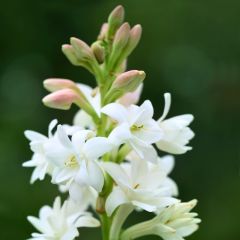
Polianthes tuberosa The Pearl
- Flowering time August to November
- Height at maturity 80 cm
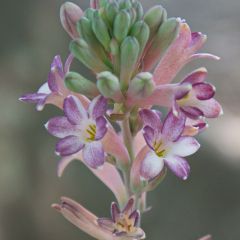
Polianthes tuberosa Sensation
- Flowering time September, October
- Height at maturity 1,20 m
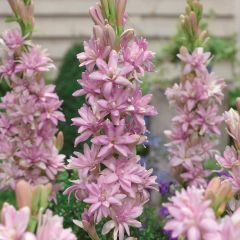
Polianthes tuberosa Pink Sapphire
- Flowering time August to October
- Height at maturity 1,20 m
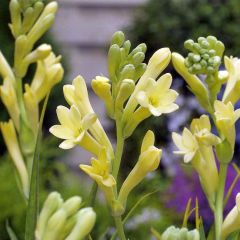
Polianthes tuberosa Yellow Baby
- Flowering time July to October
- Height at maturity 45 cm
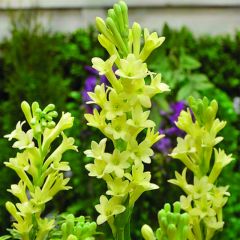
Polyanthes tuberosa Super Gold
- Flowering time September, October
- Height at maturity 75 cm
Discover other Polianthes - Tuberose
View all →Available in 0 sizes
Available in 0 sizes
Available in 1 sizes
Available in 1 sizes
Available in 1 sizes
Available in 1 sizes
Available in 1 sizes
Planting tuberoses
Where and when to plant?
Tuberoses, native to South America, are tender and frost‑sensitive plants. Reserve a warm, very sunny position for them.
Planting takes place in spring, when spring frosts are no longer to be feared. In regions with Mediterranean climates, it is possible to plant directly in ground in spring, late April or early May. To hasten flowering, it is also possible to grow your tuberoses in pots. In regions with cold climates, plant indoors and move pots outside when daytime temperatures exceed 15 degrees.
Choose a neutral pH, rich, fresh and well‑drained soil. A sandy soil, if well watered, will also suit very well. To develop well, tuberoses need plenty of light; plant them exclusively in a full‑sun position. To prevent long flower stems from breaking, plant sheltered from wind.
How to plant?
For planting in ground, allow a density of 7 to 9 bulbs per square metre; for planting in a pot, choose a pot with a minimum diameter of 25 centimetres for one bulb.
Planting in ground
- Dig a hole about ten centimetres deep. Work the soil, break up clods and remove stones. If soil is not sufficiently well drained, add sand.
- Place the bulb at the bottom of the hole and firm in.
- Water generously but without waterlogging the soil.
Planting in a pot
- Fill the pot with a mix composed of ¾ potting compost and ¼ sand.
- Place the bulb at a depth of 10 centimetres.
- Cover with potting compost and water.

Propagation of Tuberoses
Geophytes, Tuberoses are mainly propagated by dividing clumps. Each rootstock flowers only once before dying but beforehand produces two to three daughter rootstocks. These will in turn flower after a few years. When lifting the bulb from the soil, you can separate each rootstock with a knife disinfected beforehand and replant them separately in autumn.
Tuberoses can also be propagated by sowing. At the end of flowering, a capsule forms, similar to that of daffodils, containing several seeds. As soon as the capsule dries and before it opens, harvest the seeds and sow them immediately at a temperature of 20 to 25°C. Much patience will then be required; in the first year a small rootstock will form but will not flower until three to four years later.
Care
To help your tuberoses fulfil their potential, some care is necessary. Throughout growth period, in spring and summer, water regularly but avoid waterlogging soil to prevent bulbs rotting. If you fear strong winds in your garden, stake the stem to prevent it bending under weight of the flowers. Spike opens from bottom to top, so flowers do not fade at same time. As soon as a flower has faded, you can remove it by hand to avoid an untidy display. After flowering ends, reduce watering considerably but do not cut foliage: rootstock offsets must be able to store energy.
Once leaves have dried, lift rootstock and store it dry, in sand, indoors in a room at 10–15°C. If your tuberoses are in a pot, you can bring the pot indoors.
Tuberoses are not entirely free from diseases and pests but their impact is often not severe enough to prevent flowering. Mealybugs can attack your plants, as can a bacterium (Xanthomonas), and a fungus responsible for Botrytis. To eliminate mealybugs, apply a mixture of water and black soap to plants; for other diseases, best to wait…
→ Read our advice sheet: “Mealybug: identification and treatment – Our advice for natural and effective control”
If damage becomes too severe and your tuberose is surrounded by other bulbs, it is better to remove affected plant to prevent spread of disease.
Pairing Tuberoses
To create a tall border, pair your tuberoses with other tall-stemmed plants, such as Agapanthus, Gladioli or the striking Eucomis ‘Burgundy Wine’.
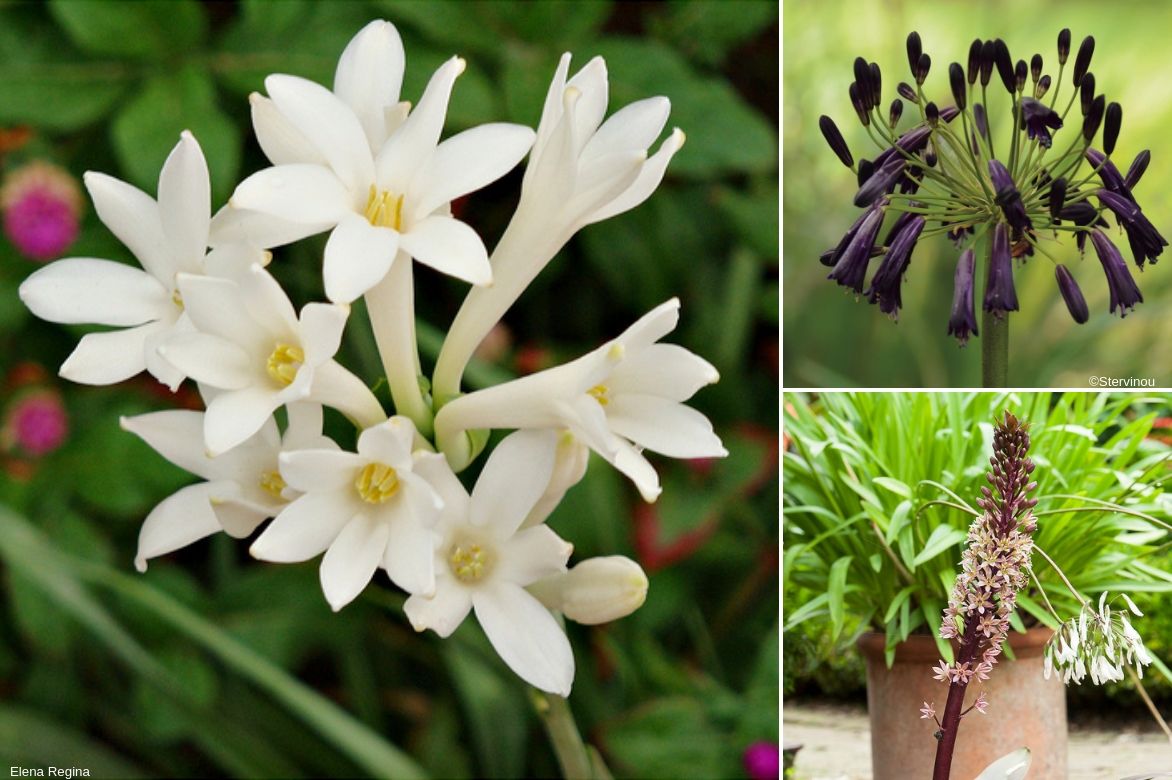
One planting idea: Agave polianthes (the variety ‘The Pearl’ features superb double flowers), Agapanthus ‘Black Magic’ and Eucomis ‘Burgundy Wine’
You can also choose to plant a small bed composed solely of tuberoses, either all the same cultivar or a mix of cultivars. Your garden will then be filled with the intoxicating charm of their fragrance.
For bouquets, tuberoses are wonderful on their own, or paired with red Snapdragons to create a striking contrast, Ranunculus, Anemones or Delphiniums. The grey-green foliage of Eucalyptus also makes an excellent backdrop for a tuberose bouquet.
Did you know?
In 1807, Jan Frans Van Dael, a Flemish painter specialising in still lifes, painted a work entitled “Vase of flowers with a broken tuberose”. Amid a tangle of flowers (tulips, roses, peonies, poppies…), a tuberose stands out, broken by the weight of its blooms. This memento mori (remember that you will die) is intended to remind the viewer of the fragility of human life. The painting is now on display at the Museum of Fine Arts in Lyon.
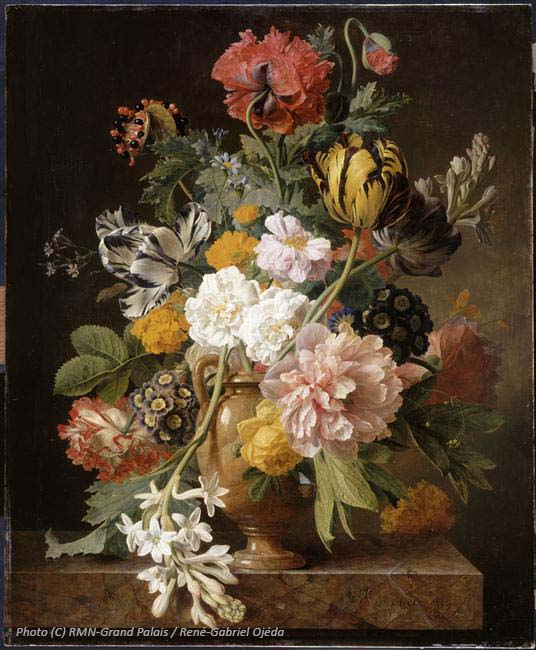
Useful resources
Discover our collection of tuberoses.
All about using tuberoses in perfumery.
A scientific article (open access, in English) to learn more about breeding of new tuberoses.
Frequently asked questions
-
How can I extend the vase life of my tuberoses?
To enjoy these fragrant bouquets for as long as possible, cut the end of the flower stems every two days and change the water. Your tuberoses will then have a vase life of about two weeks.
- Subscribe!
- Contents
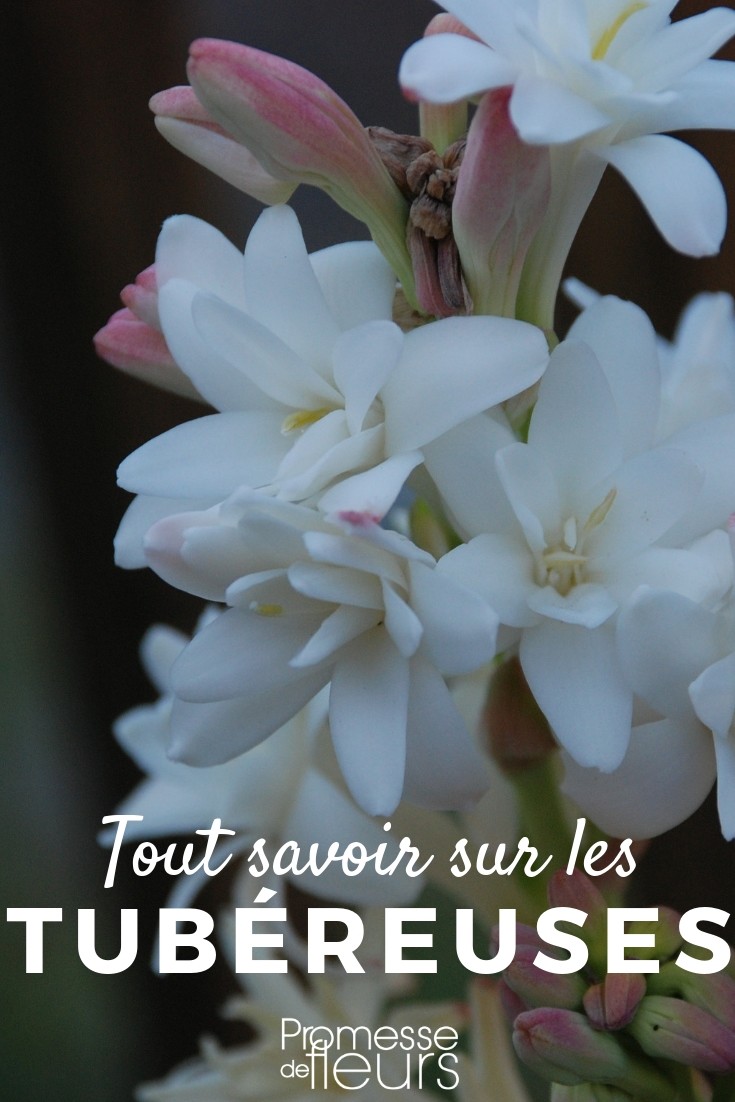































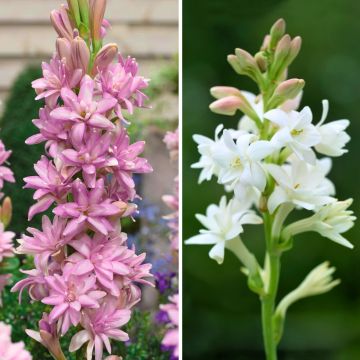






Comments